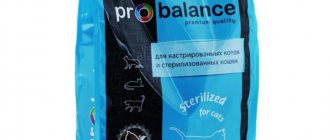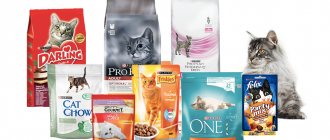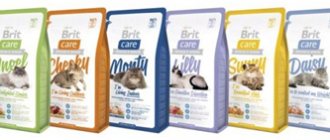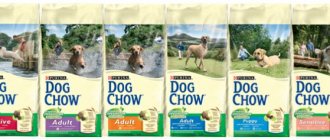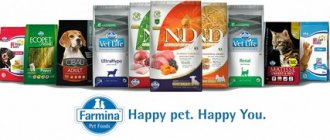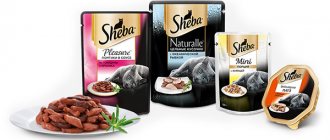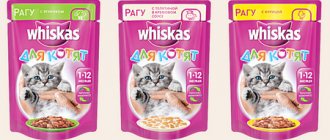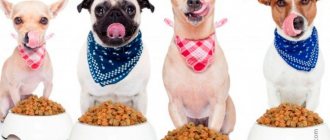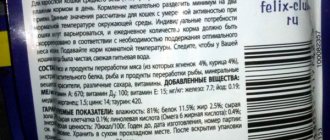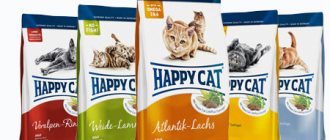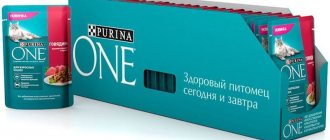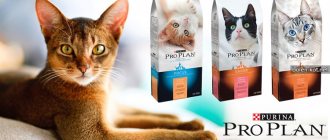The Whiskas brand appeared on the market in 1958 and has been producing animal diets for 61 years; during this period the name has become a household name for cat food. A powerful advertising campaign and a long history contribute to the popularization of products. The diets are produced based on recipes developed by the Pet Nutrition Center in America and approved by the Russian Association of Veterinarians.
general information
Whiskas is an international brand of cat food. The products are produced by the Petcare division, which is part of the Mars company. This corporation also produces Pedigree dog food, Kitiket and Royal Canin.
Whiskas food began to be produced in 1958. It became the first brand under which several types of ready-made diets with different flavoring additives were developed, which was one of the reasons for the rapid spread of popularity.
The logo is present on all packaging of Whiskas cat food
Whiskas products belong to the economy class. This means that the proportion of meat in the composition is too small, so ready-made diets should not be used for systematic feeding of cats.
General characteristics of the feed
Whiskas products are varied. Includes dry and wet diets, treats for animals. The brand was the first to introduce products with different tastes, they appeared in 1958 and quickly gained popularity among UK breeders.
Manufacturer
The manufacturer, the Mars company, is developing and opening new factories that prepare diets for pets, including in Russia. Today, products are produced in the Moscow region and Rostov-on-Don; the existence of 5 more representative offices is known.
Feed class
Despite active advertising, most pet owners know that Whiskas belongs to the category of economy class food and prefer to pamper their pets with higher quality diets. The composition shows that it is difficult to call the product balanced. The high content of by-products and a minimum of natural ingredients is supplemented with preservatives. Even if we assume that the components used are harmless to pets, their benefits are questionable.
Advantages and disadvantages
Having studied the official website of Whiskas in Russia, we see the following positive aspects of the product:
- Convenient division of diets by age groups.
- Distributed everywhere, you can buy it at your neighborhood supermarket.
- Wide selection of products with different taste characteristics.
- Feeding recommendations for each diet.
The site contains a lot of useful information for pet owners.
Read the article about the four classes of cat food.
Negative emotions are caused by:
- The composition is veiled, the ingredients are listed, but there is no percentage of the components; it is not clear what is more in the feed, meat or corn.
- Undisguised advertising raises doubts about the quality. Really good food does not need such intrusive promotion.
It is impossible not to note the company’s charitable activities aimed at protecting homeless animals, as well as the desire to instill in children a love for pets. This is an indisputable advantage of the organization, but it is unlikely to affect the quality of their products.
Types of Whiskas feed
The company produces 4 types of food: for kittens (from 1 to 12 months), for adult cats (from 1 to 7 years), for older animals (over 7 years) and for sterilized pets. Additionally, they produce products from the “Appetizing Mix” line. They produce both spiders and granulated dry food.
The company is ready to offer many different types of food, but in reality there are no significant differences between them
The lines contain only everyday ready-made diets. There are no medicinal feeds. The composition of different products from the same line differs slightly, so it is not advisable to consider the list of ingredients for each ready-made diet.
Kitten food
The line of food for kittens includes spiders and pads with filling. The first option is better, because it is easier for animals to digest a wet product.
Dry food
Whiskas pads for kittens with carrots, turkey and milk are suitable for animals from 2 to 12 months. This is due to their texture and relatively high fat content. It is not recommended to give dry food to small kittens under 2 months, as the dense consistency will cause digestive upset. As a last resort, the granules are first soaked so that the stomach and mouth are less injured by dry pieces. After 12 months, it is recommended to switch your pet to a different diet so as not to cause the development of obesity.
Cardboard packaging is not completely sealed and allows air to pass through, so this is a controversial decision
The composition includes the following ingredients:
- Wheat flour;
- animal flour: poultry meal, turkey meal (at least 4% turkey in yellow, brown and red granules), meat and bone meal;
- rice;
- protein plant extracts;
- animal fat;
- sunflower oil;
- Brewer's yeast;
- vegetables (including carrots at least 4% in yellow, brown and red granules);
- dairy products (including milk powder, minimum 4% in pillows);
- vitamins;
- minerals and taurine.
The manufacturer claims the following benefits of the formula:
- Strengthening the immune system. The composition contains zinc and vitamin E, which help the kitten’s body synthesize its own antibodies after the loss of maternal antibodies obtained with milk.
- Improving the condition of coat and skin. Zinc, vitamins A and E, as well as omega-6 unsaturated fatty acids help increase the production of skin secretions. The lipid film retains moisture in the skin and acts as a lubricant, enhancing the shine of the coat.
- Strengthening vision. Taurine and vitamin A promote normal organ development and prevent the development of eye pathologies.
- Improved bone health. Calcium and phosphorus strengthen the musculoskeletal system. The risk of fracture is reduced.
- Normalization of digestion. Plant ingredients (cereals and carrots) contain fiber, which enhances peristalsis and prevents constipation.
- Cleansing the oral cavity. Dry granules help remove plaque and prevent the formation of tartar.
There are 2 packaging options: 350 g and 1.9 kg. Large packages are more economical, but with slow consumption, the food will begin to deteriorate due to contact with air. For small kittens, it is more advisable to purchase packages of 350 g.
I would not give my kitten this food. I am personally familiar with cases where animals developed pancreatitis after such feeding. Childhood is an important period for a kitten’s body. At this time, the formation of many internal systems is completed, so the animal requires enough nutrients. There are too few of them in Whiskas products. The balance is artificially brought to normal with the help of mineral supplements, fats and vegetable protein, but in fact the nutritional value is low. There is almost no meat. This is the same as feeding a cat machine oil, calfskin and millet: it looks like there are carbohydrates, proteins and fats, but there is zero benefit.
Wet food
Wet food can be given to animals from 1 month. The increased water content and soft consistency facilitate digestion. The line contains the following products:
- lamb stew;
- chicken stew;
- salmon stew;
- veal jelly;
- turkey jelly;
- chicken pate.
Feeds differ in texture. Ragout consists of pieces of meat with a liquid sauce. The gravy in jelly is thicker. The paste is homogeneous in consistency.
It’s easier for kittens to eat wet food because it’s easier to chew it with their baby teeth
The composition differs slightly, so for example, consider the list of ingredients for chicken stew. The food contains the following components:
- meat and offal (including chicken at least 4%);
- cereals;
- vegetable oil;
- taurine;
- vitamins;
- minerals.
The manufacturer claims the following advantages:
- The presence of vitamin E in the composition. Tocopherols are essential for the proper functioning of the immune system and the maintenance of optimal skin and coat condition. Vitamin E is involved in the synthesis of new cells and enhances the production of sebaceous secretions.
- Presence of calcium. The mineral helps strengthen bones and teeth.
- High content of zinc and omega-6. The substances cause increased activity of the excretory glands, which protects the skin from drying out and peeling.
- The presence of taurine and vitamin A. Useful substances are necessary for the formation of visual organs.
Wet food for kittens contains more fat, so it can be used to feed malnourished animals.
Cats are not able to synthesize taurine from other compounds on their own, so it must be present in the food.
Spiders weigh 85 g. Sometimes you can find packages of several packs on sale. This allows you to save a little due to a discount for bulk purchases.
Large packages are more common in online stores
Not the best option for a kitten. The manufacturer suggests giving ready-made diets from 1 month, i.e. practically as the first complementary food. Once, due to my own inexperience, I offered such food to a street kitten I took home. He started vomiting. If there are no other options, it is advisable to give spiders to animals only after 2 months, when digestion has improved a little. Until this point, even a single feeding can cause serious disruption, including dehydration due to vomiting and diarrhea. In some cases this leads to death.
Food for adult cats
Food for adult cats is available in 2 versions: wet and dry. It is recommended to give granules only to those animals that independently comply with the drinking regime and do not suffer from diseases of the genitourinary system. A cat should consume at least 20–40 ml per 1 kg of weight per day.
Dry food
The company produces pate pillows in 3 flavors: salmon, chicken and turkey, and beef and rabbit. Generally speaking, the food is suitable for healthy animals from 1 to 7 years old.
The range of wet and dry Whiskas food for adult animals is the widest
The composition of different products is identical. Minor differences are associated with the types of meat used. For example, consider the composition of pillows with beef and rabbit meat. The list of ingredients contains the following components:
- Wheat flour;
- animal flour: poultry meal, beef meal, lamb meal, rabbit meal (beef, lamb and rabbit at least 4% in red-brown granules);
- plant protein extracts;
- cereals;
- animal fats and vegetable oils;
- dried chicken and pork liver;
- Brewer's yeast;
- beet pulp;
- carrot;
- mineral and vitamin mixtures.
The benefits declared by the manufacturer are the same: the presence of vitamins and minerals in the composition, strengthening the immune system and bones, supporting the development of the visual organs, etc. There are 3 packaging options: packages of 350 g, 800 g, 1.9 kg and 5 kg.
One day, a neighbor who had 2 cats at home came to me for advice. She said that the pets were in terrible condition and asked for help. The animals' fur fell out in clumps, leaving bald patches with itchy red spots. The skin came off in layers. There was no dandruff only on the stomach. I advised her to contact a veterinarian, but during the conversation it turned out that the neighbor gives her cats Whiskas food. She was very surprised to find out that this was one of the worst products, and the next day she began switching the animals to a super premium diet. During the examination, the veterinarian said that this was a severe allergy and supported the decision to change the food. After 2 weeks, the cats stopped scratching themselves until they bled, and the spots disappeared. After a month, the wounds healed, and hair began to grow on the bald areas.
Wet food
Based on consistency, wet food is divided into stews, pates, jellies, cream soups and mini-fillets. The cream soup additionally includes plant-based dry cream. The mini fillet has a consistency similar to stew. Flavorings include salmon, trout, veal, beef, turkey, etc.
There are no fundamental differences in composition, so for example, let’s look at jelly with turkey and vegetables. The list of ingredients contains the following items:
- meat and offal (including turkey at least 4%);
- vegetables (carrots at least 4%);
- cereals;
- taurine;
- vitamins;
- minerals.
The benefits declared by the manufacturer are the same. One spider weighs 85 g.
On average, pets need 2-3 spiders to get enough food
I am glad that the composition contains animal products in the first place, but I would not rush to boldly call this a full-fledged plus. Once upon a time, a friend of mine worked at one of the factories producing economy-class feed. She said that if people knew what was included in such products, they would never buy ready-made diets in their lives. I don’t know whether to believe it or not, but the general definitions (“meat,” “offal,” “turkey,” “vegetables,” and “grains”) are confusing. Among the same offal there may be liver, kidneys or hearts, as well as bladders or intestines. Many super-premium and holistic food manufacturers specify a specific type of ingredient. In the case of Whiskas products, everything is not so transparent. This makes you think: if everything in the composition was good, the manufacturer would have nothing to hide.
Food for older cats
The line of food for older cats is smaller: it contains only one granular product and 3 types of spiders. Ready-made diets are suitable for animals over 7 years old.
Dry food
The only representative is pillows with poultry pate. Theoretically, the porous texture with soft contents helps reduce stress on the teeth. The pet has to make less effort to break the granule, which partially prevents damage to the enamel and roots.
Your pet does not need to be switched to a different diet if it receives vitamin and mineral supplements as prescribed by a veterinarian
The food contains the following ingredients:
- Wheat flour;
- animal meal: poultry meal (minimum 4% in brown granules), meat and bone meal;
- protein plant extracts;
- rice;
- animal fat;
- sunflower oil;
- Brewer's yeast;
- vitamins;
- minerals and taurine.
The manufacturer claims that the composition contains glucosamine, which is necessary to maintain healthy joints. One of the advantages is a special formula to improve appetite, but the composition of the product is identical to others. Buyers can only guess what exactly keeps animals interested in the product. Most likely, these are artificial flavors that do not provide any benefit, but can cause harm. Theoretically, the caloric content of the food is lower than that of others, since weight maintenance is stated among the benefits, but the manufacturer does not disclose the nutritional value of the product on the website.
Large packages are not available for sale. The food is produced in small cardboard packs of 350 g.
The lack of specifics and general formulations cause distrust in the company. For example, the manufacturer claims that dry food helps clean teeth from plaque. For this purpose, special porous granules are produced that do not crack when pressed with fangs, but fall inside. Because of this feature, surrounding particles clean the surface of the tooth down to the roots. I specifically conducted a small experiment. In the case of Whiskas food, nothing like this was observed: the cat simply bit into the granules while eating. Perhaps the manufacturer is not lying, because such a product also cleans the tips of the fangs, but it is difficult to call this complete care. To prevent the cat from losing teeth in old age, owners will have to additionally use a special brush for animals.
Wet food
The company produces 3 types of wet food for older animals: chicken stew, lamb stew and veal pate. The composition is almost identical, however, in the pate the proportion of the declared meat component is much higher compared to analogues: 24% versus 10% and 4% in different types of stews. It also contains no grains.
It is recommended that older animals be given wet food to reduce the stress on the teeth and gastrointestinal tract.
For example, consider the composition of lamb stew. The list of components mentions the following items:
- meat and offal (including lamb at least 4%);
- cereals;
- vegetable oil;
- taurine;
- vitamins;
- minerals.
The benefits are the same as other foods. The only fundamental difference is the presence of glucosamine and components (possibly flavorings) to enhance appetite.
Food for sterilized animals
The line contains only dry food. There are 2 flavors available to choose from: chicken and veal.
The absence of wet food in the line for sterilized animals is a questionable decision
For example, consider the composition of chicken feed:
- Wheat flour;
- animal flour (including chicken flour at least 4% in brown granules);
- protein plant extracts;
- rice;
- animal fats and vegetable oils;
- dried chicken and pork liver;
- Brewer's yeast;
- vitamins and minerals.
The manufacturer states that the finished diet contains the optimal ratio of substances to maintain the health of the urinary system. However, the company does not specify what exactly helps maintain the normal state of internal organs. The composition does not differ from similar products. Perhaps the special feature of the food is its low salt content, but when it comes to the health of your pet, you don’t want to guess, but to know for sure. The product is available in packages of 350 g, 1.9 kg and 5 kg.
I don’t know how food for sterilized animals differs from regular food, but I suspect it’s only in name. I personally know of 2 cases where cats developed urolithiasis after such a diet, and I regularly encounter negative comments and reviews. After my pet was neutered, the veterinarian told me what the diet should be. If this is a ready-made diet, then it should contain a minimum of salt (only for the natural needs of the body and to preserve moisture), the presence of natural preservatives and additives to normalize the acidity of urine is welcome. It is advisable to prefer wet food, since the liquid promotes timely emptying of the bladder and prevents the increase in the saturation of urine with minerals. This prevents the formation of stones. Whiskas dry food does not meet these criteria, so it is not recommended to give it to animals after sterilization or castration.
Line “Appetizing mix”
The line includes 4 types of wet food: chicken and duck with cheese sauce, lamb and beef with cream sauce, poultry and beef with tomato jelly and shrimp with salmon and cream sauce. The composition is almost identical. The main difference is the flavoring additives. Depending on the type of food, it can be cheese or tomato powder, as well as a milk-containing product.
Tomato jelly with beef and poultry contains the following ingredients:
- meat and offal (including poultry and beef);
- cereals;
- vegetable oil;
- tomato powder;
- taurine;
- vitamins;
- minerals.
The “Appetizing Mix” line of food differs from similar products only in the presence of flavoring additives and, possibly, the percentage of components. While other ready-made diets indicate minimum contents of certain ingredients, these products do not contain specific information.
Whiskas cat food
Whiskas is one of the most popular brands of cat food. The trademark is owned by Mars, and the brand representative is Masterfoods. The manufacturer claims that the food formulation was developed based on numerous studies by the Waltham Research Center and approved by the Russian Association of Veterinarians.
Whiskas is one of the leaders in the economy class cat food market
Historical note: Frank S. Mars (Minnesota) was born in 1882. He suffered from polio, so as a child he was educated at home. His mother taught him how to make chocolate, and he spent all his time in the kitchen. In 1902, he married and started his own small business selling molasses chips. After 9 years, he began making and selling chocolate bars. In 1923, Mars began to be considered a successful businessman, as his product, Milky Way chocolate, gained popularity from the first days. After this, other products began to appear, which are now still selling successfully.
In 1934, Mars died, and his eldest son, Forest, had to take over the business. It was he who decided to add pet food to the company's treasury. True, this was only possible after the war. In 1960, Forest and the company merged. The first Russian enterprise from Mars appeared in 1995 (Moscow region). This is how the organization entered the world market. After 3 years, Forest Mars passed away, but once founded, it continued to gain momentum. The products of this manufacturer are in great demand all over the world. Currently, the company has representative offices in every progressive country in the world.
In addition to Whiskas, Mars has other brands:
- Pet products: Pedigree, Royal Canin, Kitecat, Cesar, Nutro, Sheba, Chappi, Catsan, Frolic, Perfect Fit, etc.
- Chocolate brands: M&M'S, Snickers, Dove, Mars, Milky Way, Twix, Balisti, Bounty, Maltesers, Revels, etc.
- Food products: Uncle Ben's, Dolmio, Masterfoods, Seeds Of Change, Ebly, Royco, Kan Tong, Suzi Wan, Paris, etc.
- Confectionery brands: Extra, Orbit, Altoids, DoubleMint, Juicy Fruit, Life Savers, Skittles, Wrigley's Spearmint, Starburst, etc.
What class does Whiskas food belong to?
Rebranding and advertising of food may indicate that it belongs to economy class food
Cat food may fall into one of the following classes:
- economy;
- premium;
- super premium;
- holistic.
Belonging to one of these classes is determined by the quantity and quality of meat. For example, holistic food can contain up to 90% meat. We are not talking about animal proteins (offal, bone meal, etc.), but about meat (for example, fresh lamb in Akana food). Such products cannot contain dyes or flavors; they are natural and, accordingly, have a high price. You can buy such food only in specialized stores. Such a product does not need advertising, so novice cat breeders know little about such food for cats.
Super premium class has less meat content. However, the composition should predominantly contain proteins of animal origin. Some foods in this class contain flavorings and preservatives. In terms of price, they are almost no different from holistic ones.
But the premium class means cheaper products. Premium cat food can be found in a regular pet store; it may contain dyes, preservatives, and flavorings. Meat, as a rule, is about 35% in this food. Moreover, this meat may not be of the highest quality (that’s why flavorings are needed). refer their products to this class. But some veterinarians believe this is just a publicity stunt. The basis for this opinion was the analysis of the composition. In addition, usually only the simplest products need powerful and aggressive advertising, for which PR is the only way to stay in the market.
Food advertising can be very convincing, but this is not due to the high quality of the product
Economy class food contains very little meat. Moreover, these will be derivatives of meat products (animal flour, etc.). The diet will be based on grains and plant ingredients. So that the plants in the composition do not confuse the buyer, they are usually designated by a single inaccurate word - “cereals”, etc. Meat components, on the contrary, are separated in as much detail as possible so that the composition looks as if it contains a lot of products of animal origin and plant origin. There are no components at all.
The energy value in this food is achieved thanks to vegetable proteins (corn gluten, etc.). There will also be no special components (for example, fruits or rare herbs) in such a product. There will be a bare minimum of vitamins and mineral components. The food will contain coloring (to give it an appetizing appearance), preservatives (since low-cost production technologies do not allow for long-term storage) and flavorings (otherwise the cat may simply refuse such food). Moreover, the “smallest” components in the form of, for example, dyes may not be indicated (so as not to frighten buyers with the abundance of the letter E in the composition).
One of my friends buys only cheap food for her cat. But at the same time, she studies the label every time for half an hour, claiming that she strictly follows the rules of the diet - how much protein a cat should receive and how much carbohydrates. In fact, cats (and they are natural predators) need animal protein. Even if these are just processed meat products, they are better than vegetable protein. In addition, my friend does not take artificial ingredients into account (I am usually confused by the fact that the percentage of an undesirable ingredient is not indicated).
When choosing food, you should always study the composition of the product (it is always indicated on the packaging - on the back or side)
Composition analysis
The food is almost identical in composition, so it is enough to consider 1-2 samples. As an example, let’s look at the list of ingredients for pads with beef and rabbit meat for adult cats:
- Wheat flour;
- animal flour: poultry meal, beef meal, lamb meal, rabbit meal (beef, lamb and rabbit at least 4% in red-brown granules);
- plant protein extracts;
- cereals;
- animal fats and vegetable oils;
- dried chicken and pork liver;
- Brewer's yeast;
- beet pulp;
- carrot;
- mineral and vitamin mixtures.
Wheat flour comes first. This is a source of plant proteins and carbohydrates, which the cat practically does not need. Most of the nutrients are not absorbed by the pet’s body, since carnivores have a short gastrointestinal tract adapted to digesting products of animal origin. Wheat can be harmful to a cat's health. It relatively often causes the development of allergies.
The manufacturer claims that the food contains no dyes, but this is hard to believe
The only animal products included are flour and liver. The share of the latter is comparable to the amount of brewer's yeast and vegetable oil, so it can be ignored. Animal flour is in 2nd place. It is obtained not only from pure meat, but also from industrial waste, feathers, bones, scales, etc. Such a source of protein cannot be called high-quality. In addition, the share of rabbit, lamb and beef does not exceed 4%. Judging by the manufacturer's clarification, these varieties are contained only in red-brown granules. The rest contain cheaper birds.
In total, the proportion of plant protein extracts, wheat flour and cereals is much higher than the amount of animal flour. This reduces the nutritional value of the product for cats.
Animal fats and vegetable oils help bring the nutrient balance to optimal. Unfortunately, the manufacturer does not indicate the specific type of products, so the buyer can only guess about their quality. The same goes for cereals.
The advantages include the presence of carrots and beet pulp. These are sources of fiber that aid digestion and promote the movement of stool. Coarse plant fibers cleanse the intestinal walls and remove rotting food particles.
Let's look at the composition of wet food for kittens (chicken stew):
- meat and offal (including chicken at least 4%);
- cereals;
- vegetable oil;
- taurine;
- vitamins;
- minerals.
The clarification about the minimum share of chicken is alarming, because 4% is very little for wet cat food. It is not specified what other sources of animal protein the product includes. The need for the presence of grains in a ready-made diet is questionable, so their presence in such quantities (2nd position) is a minus. Vegetable oils can be useful provided that high-quality raw materials are used and in a relatively small volume. The percentage of components and their type are not specified, so one should suspect the worst. Low-quality oils cause digestive upset and increase the load on the pancreas. Taurine, vitamins and minerals are standard feed additives. Their proportion and type have not been specified, so it is impossible to draw any conclusions.
Whiskas feed is more reminiscent of grain mixtures in composition. Such products are definitely not suitable for cats. Buyers largely have to guess about the composition of feeds. If you compare Whiskas with any product of at least super-premium class, the difference will be obvious: there are specific items in the list of ingredients. The best dry food in the entire line can be called a product for kittens. The difference is that it contains a higher proportion of rice than protein plant extracts (presumably by-products), but it also often causes nausea in animals. My colleague once tried to feed a malnourished adult cat taken from the street with it. The animal suffered from vomiting until it was switched to baby food and Acana food.
Cost and replacement feed
Prices for Whiskas products are more than fair. On average, a kilogram of dry food costs 130-140 rubles. Spiders cost about 20 rubles. per package. Veterinarians do not recommend changing the diet unless there is an indication for it. If the need arises, it makes no sense to take economy class products, especially since among the premium ones there are rations of similar prices.
Read this review article about the best wet cat food.
Foods that are often chosen as a replacement
| Name | Characteristics | price, rub. /kg. |
| Economy | ||
| Kitekat | An absolute analogue of Whiskas, the same dyes and preservatives, similar composition. | 100-130, 15 per pack of 85 g. |
| Sheba | The composition is a little better, there is more protein, but there are also offal and grains. There is no dry food or medicinal line. | 25-30 for a pouch of 85 g. |
| Premium | ||
| Royal canin | The diet is from the same manufacturer, but a higher class, more protein, although by-products and grains are also indicated, no dyes. | 500-700 |
| Iams | The composition includes meat and offal, corn (a potential allergen), a weak complex of vitamins and minerals. | 600 |
| Pro Plan | 40% protein, grains and yeast in small quantities. | 500 |
| Hill's | The composition also contains cereals. | 1200-1300 |
| Super premium | ||
| Monge | Contains corn gluten meal. | 700 |
Advantages and disadvantages of food
The disadvantages of feed include the following factors:
- Low content of meat ingredients. If it is dry food, they are below the first position. If wet, a large proportion of the composition is occupied by water and grains.
- Lack of percentage of components. There is no specific information available, so buyers cannot be sure of the quality of the food.
- Using low quality ingredients. If these are cereals, then they are not whole or even presented as a protein extract. Flour is used as meat products.
- Lack of specific information. The manufacturer does not indicate the ingredients used. This reinforces confidence in using low-quality components. Additionally, this causes inconvenience for cat owners prone to allergies.
- Veiled attempts at deception. For example, information about cleaning teeth with granules is only partially reliable. You can’t find fault here: any dry food removes some of the plaque from the ends of your teeth. However, a real preventive product should also clean the area near the roots. Buyers perceive these assurances as a guarantee of high-quality plaque removal.
- No fundamental differences between products. The composition of the feed is almost identical. Most often, the difference lies in the flavoring additives.
- Presence of the pesticide pirimiphos-methyl in trace amounts. The violation was discovered during testing by Roskachestvo. Pirimiphos-methyl is an insecticide used on cereals. In small quantities, the toxin increases the load on the stomach, liver and kidneys; in large quantities, it can cause cardiac arrest.
The angular pellets can cause your cat to accidentally injure the roof of their mouth or gums.
The list of advantages can only include the relative merits of the food. For example, according to the results of the study, the product contains no pests. In reality, all food (including economy class) must meet these requirements, so this is not a reason to be proud. Cats eat Whiskas products with pleasure and often refuse to switch to other ready-made diets, but this may be due to flavorings and flavoring additives.
The benefits and harms of Whiskas
Low cost and widespread distribution, complemented by a strong advertising campaign, make cat owners think about purchasing a diet for their pets. The cats featured in the advertisement beam at us with health and energy from the TV screen; looking at them you want to try the magic food. However, it is important to understand that an economy class product cannot ensure the presence of natural ingredients and the absence of preservatives and dyes.
Undoubtedly, Whiskas is loved by cats, which makes us think about the flavorings and flavor enhancers included in the composition, and this is not good for the animals.
On the packaging of Russian products, the composition is so vague that it is impossible to understand what was really included in the recipe and what preservatives were used for storage. There are data on the packages of the American manufacturer, and they are disappointing. One of the preservatives E250 causes poisoning at high concentrations. Since the percentage of components is unknown, it is difficult to talk about the benefits of Whiskas for cats of any age.
Looking at the reviews on the manufacturer’s domestic website, doubts arise about their natural origin. If only because the life expectancy of a cat is on average 12-15 years, animals aged 22 years are rare. The chances of owners of cats of such advanced age writing 2 reviews in a row are negligible.
In general, positive and negative user responses were divided; it is difficult to say which is more. Therefore, it is worth considering the diet individually, at first regularly checking the animal with a veterinarian. There are cases when pets choose only Whiskas and do not want to eat any other product.
Which is better: Whiskas or Friskis?
To answer the question of which food is better, you need to consider the composition of Friskis products. For example, let's look at the list of ingredients of a dry ready-made diet for adult cats:
- cereals;
- meat and its processed products;
- vegetable processing products;
- vegetable protein;
- fats and oils;
- yeast;
- preservatives;
- minerals;
- vitamins;
- dyes;
- vegetables and antioxidants.
It is impossible to say unequivocally which food is worse. Friskies products also contain dubious ingredients and vague formulations. The share of meat components is also low. There is no fundamental difference in quality.
Friskies food, like Whiskas, belongs to the economy class
The cost of "Friskies" is lower. The price of the pouch is 15–20 rubles. Small (400 g) packages of dry food cost 70-80 rubles, medium (2 kg) - 300-350 rubles, large (10 kg) - 1400-1500 rubles. However, it should be borne in mind that purchasing economy-class products means saving on your pet’s health. Late examination and treatment at the clinic may be more expensive. In addition, low-quality feeds have low nutritional value, so animals require more of them than super-premium or holistic products.
There is such a thing in the world, you most likely know about it exclusively from chocolate bars and you most likely associate it with astronomy. For almost two years of working in the pet business, this word evokes very strong feelings. This company produces the following feeds: Whiskas, Kiteket, Pedigree, Chappie. Although Friscos is produced by the Purina company, its quality is completely similar to Mars food. This is the most popular animal food among ordinary people. The population judges them solely on television advertising (fortunately, these are practically the only foods that are advertised on TV, with the exception of rare promotions), as well as from the experience of their closest acquaintances, therefore, the population considers these foods to be almost one of the most serious in the pet business industry, many they are trusted, and if they are not trusted, it is solely due to distrust of dry food in general. In more professional areas, opinion was developed quite a long time ago, and a completely definite one was developed. (I mean the field of veterinary medicine, professional breeding (breeders, nurseries), the field of trade in pet supplies, just people who are very interested in how to feed animals correctly). The following joke has become established among veterinarians: Martian food is our bread, as long as Mars exists, we will always have work, the day of the death of Mars will be a black day for the entire veterinary industry, it will be the day of the collapse of veterinary clinics.
On behalf of the group Cats... Cats... Kittens... In good hands! MOSCOW
https://vk.com/topic-17296831_30129564
Owners' opinions were divided. Some argue that food should be selected individually, because Whiskas suits some cats better, while Friskies suits others better. Other pet owners say it's best to avoid both products.
Assortment and features of feed
Whiskas has a truly wide range. Cat food can be presented in several versions:
- Dry food (pads, etc.).
- Wet food (canned food and pouches in the form of jellies, pates and stews).
- Treats and special products.
And also all Whiskas products can be classified as follows:
- food for kittens;
- food for adult cats;
- food for older cats.
Each of these products is produced in several series, and the food in each series can be dry or wet. For example, kitten food from Whiskas is available in two versions:
- pate with chicken or veal;
- jelly with veal, turkey or beef and lamb;
- stew with salmon, lamb or chicken;
- pads with milk, turkey and carrots.
